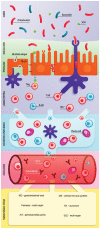The Gut Microbiota in Immune-Mediated Inflammatory Diseases
- PMID: 27462309
- PMCID: PMC4939298
- DOI: 10.3389/fmicb.2016.01081
The Gut Microbiota in Immune-Mediated Inflammatory Diseases
Abstract
The collection of microbes and their genes that exist within and on the human body, collectively known as the microbiome has emerged as a principal factor in human health and disease. Humans and microbes have established a symbiotic association over time, and perturbations in this association have been linked to several immune-mediated inflammatory diseases (IMID) including inflammatory bowel disease, rheumatoid arthritis, and multiple sclerosis. IMID is a term used to describe a group of chronic, highly disabling diseases that affect different organ systems. Though a cornerstone commonality between IMID is the idiopathic nature of disease, a considerable portion of their pathobiology overlaps including epidemiological co-occurrence, genetic susceptibility loci and environmental risk factors. At present, it is clear that persons with an IMID are at an increased risk for developing comorbidities, including additional IMID. Advancements in sequencing technologies and a parallel explosion of 16S rDNA and metagenomics community profiling studies have allowed for the characterization of microbiomes throughout the human body including the gut, in a myriad of human diseases and in health. The main challenge now is to determine if alterations of gut flora are common between IMID or, if particular changes in the gut community are in fact specific to a single disease. Herein, we review and discuss the relationships between the gut microbiota and IMID.
Keywords: chronic immune mediated inflammatory diseases; dysbiosis; metagenome; microbiome; systems microbiology.
Figures

References
-
- Abbott A. (2016). Scientists bust myth that our bodies have more bacteria than human cells. Nature 10.1038/nature.2016.19136 - DOI
-
- Adams L. A., Morrison M. (2016). The microbiome in obesity, diabetes, and NAFLD: what is your gut telling us? Curr. Hepatol. Rep. 15 96–102. 10.1007/s11901-016-0299-5 - DOI
-
- Alard P., Parnell S., Manirarora J., Kosiewicz M., Atay S. (2009). Probiotics control lupus progression via induction of regulatory cells and IL-10 production. J. Immunol. 182:30.
Publication types
LinkOut - more resources
Full Text Sources
Other Literature Sources

